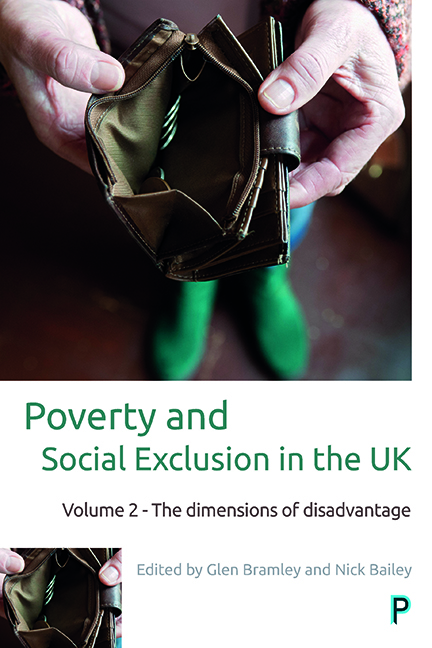thirteen - The multidimensional analysis of social exclusion
Published online by Cambridge University Press: 12 April 2022
Summary
Introduction
Previous chapters in this volume explore different dimensions of poverty and social exclusion in the UK, while the companion volume (Dermott and Main, 2017) presents evidence on the poverty and social exclusion experienced by different social groups or in different locations. Although many of these contributions also examine how disadvantage in one area relates to disadvantage in others, they essentially focus on one or two aspects of exclusion at a time. This chapter seeks to bring these analyses together by presenting an overarching multidimensional analysis of social exclusion, exploring in more depth the relationships between the dimensions of exclusion. As noted in the Introduction, there are many ways in which this task could have been approached. Rather than selecting just one, this chapter explores complementary approaches using a range of statistical techniques. By doing so, we hope the results provide a more holistic understanding of how different domains of exclusion relate to each other and of the different forms which social exclusion may take.
The chapter is organised into a number of sections. The first provides an introduction to the concept of social exclusion, while the second describes levels of exclusion using the main indicators available in the PSE-UK 2012 survey and, where available, how these have changed since 1999. The chapter then discusses two different approaches to constructing broader measures of exclusion for each domain or groups of domains, in order to facilitate the multidimensional analysis which follows. The results of this multidimensional analysis are then presented, exploring the relationships between domains, and the variations in the forms of exclusion across different social groups, including between poor and non-poor groups. Lastly, the chapter considers the wider significance of these findings for policies to promote social inclusion and well-being in the UK.
The concept of social exclusion
As noted in the Introduction, the concept of social exclusion emerged into UK discourses on poverty and living standards from France in the early 1990s (Bradshaw, 2004). Early advocates, including Room (1995), argued that it expanded on income- and expenditure-based measures of poverty by adopting a more dynamic, multidimensional perspective which emphasised the structural processes underpinning disadvantage. Despite fundamental differences in views on its causes (and appropriate policy responses), some consensus is evident in its conceptualisation in academic and policy research.
- Type
- Chapter
- Information
- Poverty and Social Exclusion in the UK Vol 2The dimensions of disadvantage, pp. 311 - 342Publisher: Bristol University PressPrint publication year: 2017
- 1
- Cited by



